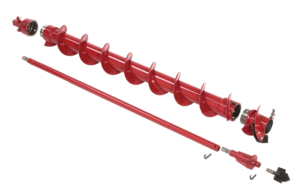How to determine whether to use a solid-stem auger or hollow-stem auger
Solid-stem augers and hollow-stem augers can both be used to extract soil samples, but even though these augers do the same job, the type you should use comes down to the soil conditions where you’re drilling. Check out these tips to determine which soil sampling auger is best for your project.

When to Use a Solid-Stem Auger
Solid stem augers have a solid shaft with a continuous spiral steel blade on the outside and a drill bit connected to the bottom to easily drive through the soil. This type of auger is commonly used for earth drilling, but can also be used for soil sampling with a split spoon sampler to collect a soil sample from the borehole.
If you’re planning to use a solid-stem auger for soil sampling, you’ll want to make sure you’re drilling in cohesive soil, or soil with a high clay content that is usually fine-grained and stays intact when the soil is disturbed. If a solid-stem auger is used in an area with sand or gravel, the soil will collapse back into the hole when the auger is pulled out of the ground.
Little Beaver, the parent company of Lone Star Drills, offers solid stem augers that are compatible with the LST1G+, LST1G+HD and LST1G+HDA as well as the Big Beaver. Little Beaver also makes achieving a variety of borehole depths possible with auger extensions that can easily snap on to your existing auger.
When to Use a Hollow-Stem Auger
A hollow-stem auger works like a solid stem auger but with a claw bit attached to a hollow stem. Once the borehole reaches the preferred depth, the hollow stem acts like a casing to keep the sides of the borehole from caving in. Hollow stem augers from Little Beaver come in 6- and 8-inch diameters with 2 ¾- or 3 ¾-inch internal diameters. The center rod and center plug on the hollow stem auger can be removed to create a clear path for inserting a split spoon sampler on drill rods through the open end of the auger.

Similar to its solid-stem counterpart, the hollow-stem auger is compatible with the LST1G+, LST1G+HD and LST1G+HDA in addition to the Big Beaver. But unlike the solid-stem auger, the hollow stem auger excels in unstable or non-cohesive soil such as sand and gravel. It’s important to understand that non-cohesive soils have a structural strength that is dependent on moisture content, which means if you’re gathering a soil sample after it has recently rained, the soil will stick together almost like cohesive soil. In these cases, you’ll still want to use a hollow-stem auger for collecting a soil sample because as the soil dries it will go back to its normal state.
Next Steps for Success
Soil sampling tools like the solid-stem auger, split-spoon sampler and hollow-stem auger can easily help you achieve your goals when used correctly. Our drills make soil sampling easier than ever with heavy-duty steel frames for rugged durability, and a variety of transportation and size options for confined spaces and difficult-to-access areas.
If you have additional questions or you’re unsure which soil sampling tool to choose based on your soil type, we suggest contacting Little Beaver or Lone Star Drills. Our experts are happy to provide more information and suggestions based on your requirements.